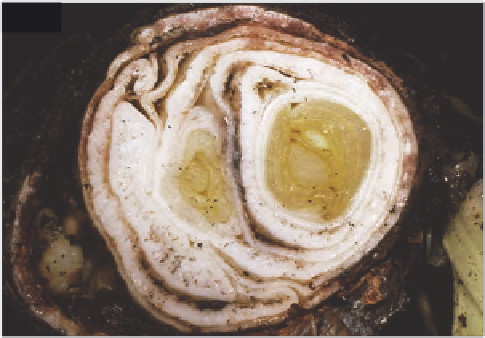Biology Reference
In-Depth Information
1148
1148
Stem nematode (
Ditylenchus dipsaci
) damage to bulb of
Narcissus
.
masses of eggs. In some cases development of the pest is
parthenogenetic; in others, minute worm-like males
mate with the females before eggs are laid. First-stage
juveniles develop within the eggs, second-stage
individuals eventually breaking free and either migrating
inside the root or escaping into the soil to commence
feeding elsewhere. These infective nematodes are
capable of surviving in moist soil for about three months.
In dry conditions they persist for no more than a few
weeks.
symptoms vary from host to host but commonly include
stunting, crinkling, twisting, swelling or malformation
of leaves, leaf stalks, flowers and stems; infested tissue
may also split.
Aubretia
, bell flower (
Campanula
),
evening primrose (
Oenothera
), golden-rod (
Solidago
virgaurea
),
Gypsophila, Heuchera
, sneezewort
(
Helenium
),
Hydrangea, Phlox
, primrose (
Primula
vulgaris
) and sweet william (
Dianthus barbatus
) are
often affected. Bulbous plants such as daffodil
(
Narcissus
), hyacinth (
Hyacinthus orientalis
),
snowdrop (
Galanthus nivalis
) and tulip (
Tulipa
) are also
important hosts. Leaves arising from infested daffodil
bulbs often develop small, yellowish swellings
('spickels'); also, when infested bulbs are sliced open,
brown rings of damaged tissue may be visible where the
scales have been destroyed. In tulips, flower stalks from
heavily infested bulbs are bent and develop lesions
which eventually split open; flowers also fail to colour
properly, the petals remaining partly green. Bulbs
damaged by nematodes may eventually rot, and they are
often invaded by secondary organisms such as small
narcissus flies (
Eumerus
spp.) (p. 190) and bulb mites
(
Rhizoglyphus
spp.) (p. 433).
Potato tuber nematode (
Ditylenchus destructor
) is
similar to stem nematode but lacks a resistant stage
capable of surviving periods of desiccation. Also, unlike
stem nematode, it is restricted mainly to the
subterranean parts of plants, producing dry, brownish or
blackish lesions on bulbs, corms, roots and tubers.
Various ornamentals are affected, including bulbous
Iris
,
Colchicum
,
Dahlia
,
Gladiolus
and tulip (
Tulipa
);
leaves developing from damaged bulbs are weakened
and often have yellow tips. Damaged tissue is
frequently invaded by secondary organisms, including
bacteria, fungi and mites.
Stem nematodes and tuber nematodes
(
1148
)
Stem nematode (
Ditylenchus dipsaci
) is a major pest of
herbaceous and bulbous plants, including many
ornamentals. The pest exists as several distinct races or
strains - the hyacinth, narcissus, onion, phlox and tulip
races are examples. Some races affect a wide variety of
host plants, including cultivated plants and weeds,
whereas others are more specific. Plants are invaded by
adults and final-stage (fourth-stage) juveniles, which
move through the soil in moisture films. The nematodes
gain entry to host plants via wounds and lenticels in the
basal parts of stems or through stomata in leaves in
contact with the ground; roots are not attacked. Adults
are minute (
c
. 1.2 mm long) and thread-like. They feed
and breed continuously in suitable hosts, development
from egg to adult taking about three weeks at 15°C. In
the absence of host plants, stem nematodes are able to
survive in moist soil for up to a year; however, they are
more resistant to desiccation, fourth-stage juveniles
often congregating in their thousands and drying out to
form yellowish, woolly masses ('nematode wool').
These desiccated nematodes are able to survive
unfavourable conditions, remaining viable and
potentially infective for several years. Damage

Search WWH ::

Custom Search